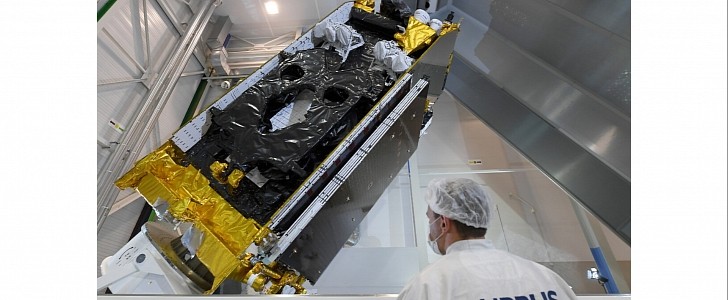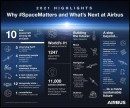Airbus has confirmed its leading position in the aerospace world, with numerous successes throughout 2021. From the launch of ten new satellites to contributing to the historical mission of the James Webb telescope, this space technology giant has helped advance our interaction with space through innovative applications.
Satellites are more and more important in a wide range of domains, and Airbus was actively involved in some of the most important ones. Together with Inmarsat, a well-known telecommunications company, it launched the Inmarsat-6 F1 project, one of the first satellites to be powered by an electric propulsion system, based on the Airbus Eurostar E3000 spacecraft. Even more importantly, the Inmarsat-6 was the first to carry a hybrid communications technology (a large L-band antenna, plus nine multibeam Ka-band antennas) for top-level coverage and speed.
Airbus also built an innovative satellite for biomass measurements. Launched by the European Space Agency (ESA), this satellite was designed to measure biomass levels in tropical forests, with the goal of combating climate change. Its main innovation was a large reflector that opened like an umbrella in orbit, to receive P-band data from Earth. This marked the first time that a long-wavelength P-band radar is used in space.
The company’s expertise was also used for the launch of France’s three CERES reconnaissance satellites that claim to have one of the best signal intelligence capabilities in the world. Airbus was also responsible for designing and producing six of the Galileo second-generation navigation satellites, boasting the latest technology in payload processing, electric propulsion, and active antennas.
In addition to all of these accomplishments, the European aerospace specialist was also part of the James Webb telescope international project. More specifically, it provided one of the telescope’s four instruments, the NIRSpec. Also known as the “super-eye,” this multi-object spectrograph can measure the near infrared spectrum of at least 100 stars at the same time.
This year is expected to be just as exciting for space innovations, but Airbus also pointed out that keeping space free of debris should be one of the top priorities.
Airbus also built an innovative satellite for biomass measurements. Launched by the European Space Agency (ESA), this satellite was designed to measure biomass levels in tropical forests, with the goal of combating climate change. Its main innovation was a large reflector that opened like an umbrella in orbit, to receive P-band data from Earth. This marked the first time that a long-wavelength P-band radar is used in space.
The company’s expertise was also used for the launch of France’s three CERES reconnaissance satellites that claim to have one of the best signal intelligence capabilities in the world. Airbus was also responsible for designing and producing six of the Galileo second-generation navigation satellites, boasting the latest technology in payload processing, electric propulsion, and active antennas.
In addition to all of these accomplishments, the European aerospace specialist was also part of the James Webb telescope international project. More specifically, it provided one of the telescope’s four instruments, the NIRSpec. Also known as the “super-eye,” this multi-object spectrograph can measure the near infrared spectrum of at least 100 stars at the same time.
This year is expected to be just as exciting for space innovations, but Airbus also pointed out that keeping space free of debris should be one of the top priorities.






